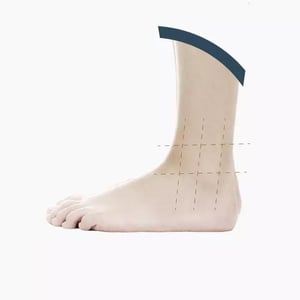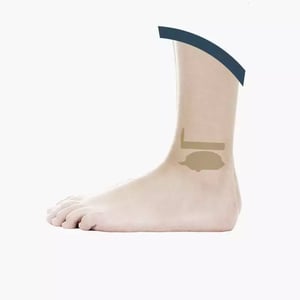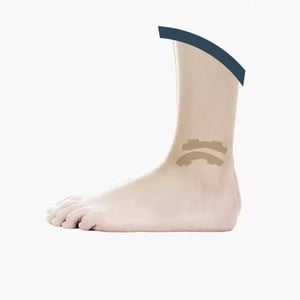From Arthrodesis to Prosthesis
You don’t need to rip off pages of life, just know how to turn the page and restart.
– Jim Morrison –
Introduction
Arthrodesis is an orthopedic procedure that involves fusing a joint. In the case of ankle arthrodesis, the goal is to fuse the bones of the ankle joint.
Historically, this surgery was the only available option for treating ankle arthritis.
Today, there are several alternatives that focus on preserving movement, falling into two main categories:
- Joint-preserving surgery: This approach aims to save the joint by realigning deformities and promoting cartilage regeneration.
- Ankle arthroplasty: This involves replacing the damaged joint with a prosthesis to restore function.
Therefore, it is accurate to say that arthrodesis is now only considered when movement preservation is not achievable through joint-preserving surgery or arthroplasty.
However, arthrodesis was once a very common solution, and today, many patients continue to live with an ankle arthrodesis.
If the arthrodesis is properly positioned, with the foot supported physiologically and the ankle at a 90° angle, the patient is likely to be satisfied with the outcome and can lead a normal life, free from a limp or severe limitations.
However, over time, the loss of function in such a critical joint as the ankle can cause the nearby joints to compensate and bear more stress.
Studies show that patients who undergo ankle arthrodesis have a significantly higher risk of developing osteoarthritis in the adjacent joints, potentially requiring further surgery to address these complications.
Why can Arthrodesis Become Painful?

Se analizzassimo le caratteristiche del paziente affetto da artrosi di caviglia, rimarremmo stupiti di quale profondo impatto negativo abbia sulla qualità della vita di questi sfortunati pazienti.
Arthrodesis can become painful and induce severe disability in a patient in the following 3 cases:
- Onset of osteoarthritis in the adjacent joints [a problem that typically occurs in the long term]
- The arthrodesis has not stabilized in the correct alignment.
Most often, a misalignment occurs in equinus [i.e., "on tiptoe"]. In these cases, walking is painful, and disability and limp are significant, often involving the knee in compensating for this deformity; - The arthrodesis has not healed, meaning it is not consolidated.
Disarthrodesis: Revising Painful Arthrodesis

The surgical solution of disarthrodesis is undoubtedly facilitated by a lateral approach, although it is objectively possible to perform it through an anterior approach as well.
The advantage of the lateral approach lies in the full visualization it offers of the arthrodesis plane, allowing for precise planning not only of the future joint's alignment, but also of its center of rotation.
In addition, the lateral approach offers another significant advantage: the ability to perform an effective release (lysis) of the posterior soft tissues (muscles and tendons), which are often adhered to the bone surface after many years of fusion due to the arthrodesis.
In my experience, the lateral approach is generally the preferred choice for disarthrodesis, with overall surgical timing comparable to that of a standard ankle replacement.
However, this is a technically more challenging procedure—for the entire surgical team: surgeons, nurses, and patients alike. For this reason, careful preoperative planning and a thorough evaluation of risks and benefits are essential. Finally, it is essential that the procedure be scheduled at a specialized reference center, where the entire team is experienced and well-acquainted with the proposed surgical approach.
Who is an “Ideal” Candidate for Disarthrodesis?
Having an ankle arthrodesis alone is not enough to qualify as a candidate for ankle arthroplasty.
There are patients with completely asymptomatic arthrodesis or only mild discomfort—these individuals are not suitable candidates for such a complex procedure.
It’s important to remember that this surgical path is intended for patients with significant disability.
The goal of disarthrodesis is to restore a plantigrade foot—that is, a foot that supports the ankle at a physiological 90° angle and allows for some degree of flexion and extension.
It’s unrealistic to expect disarthrodesis to restore full, natural ankle movement. It will never perform like a healthy, native joint.
That said, a successful disarthrodesis is far preferable to a painful and disabling arthrodesis, even if the range of motion remains limited.
This decision must always be based on careful, balanced consideration. Disarthrodesis is not a procedure chosen out of regret for having had an arthrodesis instead of an arthroplasty—it is reserved for those cases in which the arthrodesis has become painful and functionally limiting.
Expert Consultation for Arthrodesis Revision

The recommendation for disarthrodesis is made during a specialist consultation, where it is important to bring comprehensive imaging studies and recent blood tests.
Blood tests—including complete blood count, ESR, CRP, and fibrinogen—are essential to help rule out an ongoing infection. If an infection is suspected, disarthrodesis cannot proceed. Instead, a temporary surgical procedure will be planned to address and resolve the infection first.
Imaging plays a critical role, especially weight-bearing X-rays of the foot and ankle taken while standing. These are vital for accurately assessing the deformity.
An X-ray taken when the patient is lying down is essential for a correct study of the deformity.
It is also highly beneficial to have imaging of the opposite (unaffected) side available, as it provides a reference for the patient’s original, healthy anatomy.
Lastly, weight-bearing X-rays and a CT scan are the key investigations for evaluating bone quality and assessing the feasibility of the surgery. For an ankle arthroplasty to succeed, the implant must be supported by bone of sufficient strength and quality to ensure its long-term stability.
Post-Operative Recovery path
Each of our prosthetic surgeries follows a well-defined protocol that actually begins before the operation itself—with the choice of anesthesia.
We adhere to a protocol inspired by the principles of Rapid Recovery, commonly applied in prosthetic surgery for other joints. Typically, the patient undergoes peripheral (regional) anesthesia, which may be combined with sedation or general anesthesia if necessary.
This approach ensures that the patient experiences a sensation of numbness in the leg for as long as possible—sometimes lasting until the following day—which provides excellent postoperative pain control.
Additionally, the patient will leave the operating room with a fiberglass cast, which will be worn for approximately four weeks.
Discharge from the hospital typically occurs between 2 to 3 days after surgery.
At home, the patient is advised to keep the limb elevated and to perform both active and passive movements of the toes.
The first follow-up visit is scheduled after 15 days for suture removal and to begin a gradual return to weight-bearing.
The cast remains in place for a total of four weeks, after which the patient transitions to wearing a brace that allows full weight-bearing.
The brace is typically worn for about 15 days. After this period, the patient can resume full weight-bearing, potentially without the need for crutches.
Overall, the recovery process is similar to that of a standard ankle arthroplasty.
However, it is important to note that patient satisfaction may take longer to fully develop, often becoming apparent around 10 to 12 months post-surgery.


